Mark Rodrigues1
This article seeks to contribute to our understanding of first home buyer behaviour, presenting a profile of first home buyers in Australia at various points in time over the past two decades. Understanding the social and economic characteristics of first home buyers, and how they have evolved over time, is an important input into the current debate on housing affordability.
While rising house prices have reduced affordability for first home buyers in recent years, first home buyer participation in the market remains consistent with demographic fundamentals, suggesting that - in aggregate - aspiring first home buyers are not being priced out of home ownership. This may be because other elements of affordability, such as first home buyer incomes and employment, have grown strongly in recent years, consistent with the strong domestic economy, and because of the lower cost and increased availability of credit.
Introduction
Home ownership is highly valued in Australian society. At an individual level, it is believed to provide benefits such as security, freedom and privacy, as well as a tangible investment vehicle through a regime of disciplined saving. At a broader level, it plays a central role in promoting social cohesion, participation and stability.2 The importance of home ownership is reflected in Australia's rate of home ownership which, at around 70 per cent, is among the highest in the developed world.3
The substantial increase in established house prices in recent years has raised concerns that aspiring first home buyers are being priced out of home ownership, resulting in a reduced rate of home ownership.
To date, these concerns have been supported using evidence from summary measures of conditions in the first home buyer market, such as the proportion of applicants obtaining finance to purchase their first home relative to the rest of the market, and various housing affordability indicators. However, such measures by themselves can be misleading. Either by design or assumption, they typically approximate conditions experienced by home purchasers more broadly rather than by first home buyers specifically. In addition, summary measures by definition do not factor in all, and in many cases even most, of the determinants of home purchase decisions.
In order to assess the extent to which, if at all, first home buyers are having difficulty entering the housing market, the analysis must go beyond median measures of prices and income. Other factors such as the types and prices of homes specific to first home buyers, the relative ease of access to credit, the cost of credit, employment conditions and incomes, and life-cycle developments should also be considered.
This article looks at first home buyer-specific data to present an in-depth profile of first home buyers. Knowledge of the broader set of factors that weigh on first home purchase decisions should improve understanding of observed trends in first home buyer activity.
To do this, the article firstly analyses the extent to which first home buyer activity has fallen recently and the factors behind the decline. It is shown that the decline in first home buyer activity largely reflects an unwinding of the bring-forward associated with the additional First Home Owners Scheme (FHOS). Abstracting from this, the number of first home buyers currently purchasing homes appears broadly consistent with demographic trends.
The remaining sections of the article focus on the demographic, social and economic characteristics of recent entrants into the housing market, with a view to better understanding the factors underpinning the first home purchase decision. Some of the factors considered include the age and life-cycle cohort of first home buyers, the types of homes they purchase, and affordability indicators such as income, the cost and availability of finance, and employment status. The article concludes with a discussion of the findings, relating them back to observed first home buyer behaviour.
It should be noted that the data used to provide a demographic and social profile of first home buyers are most recently available for the three years to 2000-01. However, such characteristics evolve slowly over time, and therefore should remain relevant for more recent years. Economic variables are discussed with contemporary data sets (eg. finance and house prices). In addition, the results presented in this article are for all first home buyers, on average across all cities and regional areas, and hence may not necessarily be representative of conditions at the regional or individual level.
Recent trends in first home buyer activity
Part of the current debate on housing affordability has focused on the recent decline in the proportion of first home buyers in the owner-occupier housing finance market (excluding refinancing), from a peak of around 33 per cent two years ago to 19 per cent currently (see Chart 1). However, this measure is directly influenced by the significant strength in total market activity and the bring-forward and unwind of first home buyer activity associated with the FHOS.
Chart 1: Proportion of first home buyer finance approvals(a)
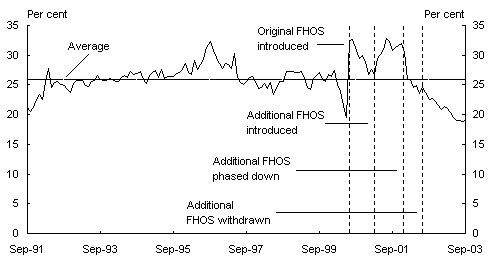
(a) Proportion of owner-occupied housing finance market (excluding refinancing).
Source: Australian Bureau of Statistics, Housing Finance for Owner Occupation, Cat. No. 5609.0.
Activity in the owner-occupier housing finance market (excluding refinancing) has risen from around 430,000 sales in 2000-01 to around 460,000 sales in 2002-03. As a consequence of the significant increase in sales activity, measures of first home buyer activity as a proportion of the total market are therefore likely to overstate the decline in the first home buyer segment of the market, given that first home buyer activity is motivated by different factors to that of the total market. The total market includes a significant number of sales related to either investment properties or those households upgrading (or downgrading) their current homes (see accompanying article, Recent developments in the Australian housing market).
Given the problems associated with analysing first home buyer activity relative to the rest of the market, it is likely to be more useful to focus on the actual number of first home buyers (see Chart 2).
Chart 2: Number of first home buyer finance approvals
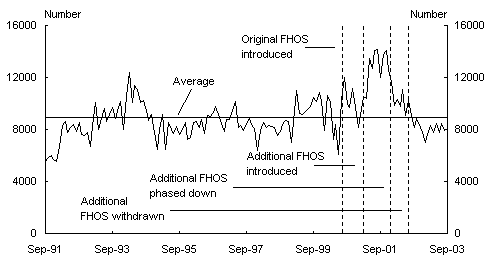
Source: Australian Bureau of Statistics, Housing Finance for Owner Occupation, Cat. No. 5609.0.
First home buyer activity has been relatively volatile in recent years as first time home buyers responded to the incentives implicit in both the original and additional FHOS (see Box 1 for an explanation of the rationale behind the FHOS).4 The number of first home buyers obtaining finance fell to a low of around 6,000 per month prior to the introduction of the original FHOS on 1 July 2000, as aspiring first home buyers delayed their purchase to obtain the grant. Subsequently, first home buyer activity rebounded to a peak of over 12,000 per month following the introduction of the grant, reflecting the release of pent-up first home buyer demand. The additional FHOS, which was announced in March 2001, further stimulated demand, with the number of first home buyers averaging around 13,000 per month over the remainder of 2001. Thereafter, as expected, first home buyer participation in the market has
fallen steadily, as the additional grant was phased down in January 2002, and eventually withdrawn in July 2002.
It is estimated that the unwinding of the bring-forward associated with the additional FHOS is now largely complete.
Looking through the recent volatility associated with the FHOS, the number of first home buyers is currently only slightly below its average since the early 1990s of just under 9,000 per month. Taking into account the unwinding of the earlier bring-forward, this may suggest that first home buyers are still gaining entry into the housing market at similar rates as in the past.
Since the population in the primary first home buyer age cohort (25 to 34 years) - one of the fundamental drivers of first home buyer demand - remained relatively stable over this period, a comparison with the long-run average is reasonable (see Chart 3). Other factors that have a major influence on first home purchases are discussed in the next section and, as the analysis demonstrates, these factors have been relatively stable as well.
Chart 3: Population aged 25-34 years
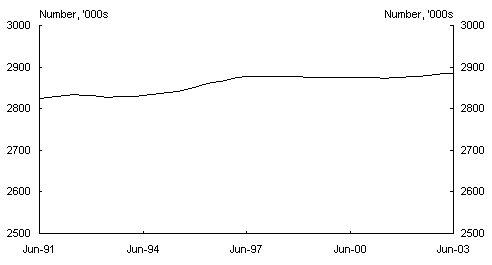
Source: Australian Bureau of Statistics, Population by Age and Sex, Cat. No. 3201.0.
|
Box 1: The rationale behind the First Home Owners Scheme The FHOS was originally introduced on 1 July 2000 in order to compensate for price increases associated with the introduction of the Goods and Services Tax (GST). The scheme provides for a $7,000 payment to be made to first time home buyers who enter into a contract to purchase a home - new or established - on or after 1 July 2000. While the GST is only levied on new homes, and the majority of first home buyers - some 80 per cent on average - purchase established homes, it was recognised that the increased cost of new homes would eventually flow through to the established market, as demand adjusted to the change in relative prices. While the original FHOS represents compensation for the GST, and as such should have had a neutral effect on housing affordability, the willingness of first home buyers to defer purchases until its introduction suggests it was perceived as having some additional benefit over and above compensation for the GST. In contrast, the additional FHOS that was introduced in March 2001, was designed to provide a short-term stimulus to activity in the residential construction sector. As such, the additional grant was introduced for a limited period, and applied only to first home buyers purchasing or building a new home. The additional grant had an immediate impact on the first home buyer market, and the residential construction sector more generally. First, it brought forward the purchase decision to within the time frame specified within the grant. Second, it encouraged first home buyers who would otherwise have purchased an established dwelling to purchase a new dwelling. And third, it enabled a small number of people, who may never have become home owners, to purchase a home. It is important to note that while much of the increase in first home buyer activity in the second half of 2001 was a bring-forward of activity associated with the grant, which has subsequently been unwound, some of the increase in first home buyer activity was also due to low interest rates. With respect to its impact on housing affordability, the original FHOS - considered as compensation for the GST - should have had a neutral impact on affordability. The additional FHOS is likely to have improved affordability for the first home buyers who received it, since any increase in first home prices associated with the additional grant would have been limited by the targeted nature of the grant (new homes). |
Who are first home buyers?
Data in this section come from the Australian Bureau of Statistics' Survey of Income and Housing Costs for the years 1981-82, 1995-96 and 2000-01.5 Although the Survey of Income and Housing Costs is available for other years, these years were chosen to provide an adequate time span over which to analyse slowly evolving trends. For the purposes of this section, first home buyers refer to income units where the reference person has purchased a home within three years of the relevant survey, and had not previously owned or been purchasing a home.6
In the three years to 2000-01, around 420,000 Australians purchased their first home (see Table 1). Of these, around 86 per cent had a mortgage while the remaining 14 per cent did not have a mortgage. The surprisingly high proportion of first home buyers without a mortgage - which has remained relatively stable over the past two decades - possibly reflects the existence of high wealth individuals.7 It may also reflect the influence of recent immigrants purchasing their first home in Australia using the proceeds from the sale of their home overseas. Nevertheless, given the nature of the issues being examined, the remainder of this article will focus on first home buyers with a mortgage.
Table 1: First home buyers, number and tenure type

Source: Australian Bureau of Statistics, Survey of Income and Housing Costs, Cat. No. 6541.0.30.001.
Age and life-cycle characteristics of first home buyers
In broad terms, over the past two decades, first home buyers in Australia are most likely to have been relatively young, with over 60 per cent aged between 25 and 34 years (see Table 2). Further, the likelihood of being a first home buyer diminishes significantly with age, reflecting the fact that older people are more likely to already be existing home owners.
Table 2: Age of first home buyers with a mortgage
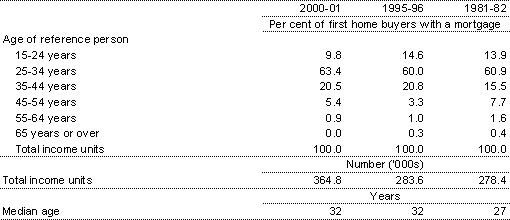
Source: Australian Bureau of Statistics, Survey of Income and Housing Costs, Cat. No. 6541.0.30.001.
That said, the average age of first home buyers has increased. Between 1981-82 and 1995-96, the median age of first home buyers increased from 27 years to 32 years. However, this has stabilised at 32 years over the past 5 years.
Some have linked the ageing of the first home buyer cohort to declining affordability (see for example Yates, 2002). However, the stabilisation of the median first home buyer age between 1995-96 and 2000-01 coincides with a strong rise in house prices (up 36 per cent). So it is not clear that the earlier ageing of the first home buyer cohort was related to declining affordability. Also, there is substantial evidence to suggest that the increased delay in home purchasing between 1981-82 and 1995-96 may be related to broader social changes. Such changes include the deferral in family formation, which has traditionally preceded home purchase, longer periods spent in higher education or training, the changing composition of households, and the attractiveness of alternative forms of investment (Baum and Wulff, 2003).
Some of these social changes are evident in developments in the life-cycle characteristics of first home buyers over the past twenty years. For example, consistent with the tradition of partnering and family formation before home purchase, couples (with or without children) remain the most common group of first home buyers. However, they have been a declining proportion of first home buyers over the past twenty years. This decline is almost fully accounted for by
the fall in the proportion of first home buyers who are couples without dependent children where the reference person is aged 35 years or older (see Table 3).
This has been offset by an increase in the proportion of first home buyers who are lone persons, from around 20 per cent of first home buyers in 1981-82 to over 30 per cent in 2000-01. Most of these were under the age of 35.
Couples with children represented over a third of households that bought their first home in the three years to 2000-01. This is broadly unchanged from the early 1980s.
Table 3: Selected life-cycle characteristics of first home buyers with a mortgage

Source: Australian Bureau of Statistics, Survey of Income and Housing Costs, Cat. No. 6541.0.30.001.
Types of homes purchased by first home buyers
The types of homes sought by first home buyers are also an important element of the home purchase equation. In general, the type of housing chosen by first time home buyers is consistent with the stage of life-cycle developments outlined above, their incomes (which is discussed in the following section), and the type of housing stock available in Australia.
Detached houses remain the most common type of home purchased, representing over 80 per cent of all homes purchased by first home buyers in 2000-01 (see Table 4). This is consistent with the predominance of families - couples with or without dependent children - in the first home buyer cohort, and the relative proportion of detached houses in the housing stock. That said, higher density dwellings represent an increasing proportion of homes purchased by first home buyers, increasing from around 10 per cent two decades ago, to around 20 per cent in 2000-01. Again, this is consistent with the increasing proportion of first home buyers who are lone persons, and the increasing proportion of higher density dwellings in the overall housing stock.
Table 4: Type of dwelling purchased

Source: Australian Bureau of Statistics, Survey of Income and Housing Costs, Cat. No. 6541.0.30.001.
The vast majority of first home buyers purchase established homes (see Table 5). In 2000-01, over 80 per cent of first time home buyers purchased an established home, up slightly from 1995-96. Consistent with this, more recent FHOS data suggest that the proportion of first home buyers purchasing established homes has remained at a little over 80 per cent in the period since mid-2001.
The majority of first home buyers - over three quarters - purchase large houses with three or more bedrooms. This may be related to the needs of first home buyers, most of whom have a family. Further, there is evidence to suggest that the size of the homes purchased by first home buyers, as measured by the number of bedrooms, has increased over the past two decades. This in part reflects the increase in the size of new dwellings being built for the total market (Australian Bureau of Statistics, 1999).
Importantly, however, the increasing size of homes being purchased by first home buyers suggests that part of the higher prices being paid has been for an improvement in quality.
Table 5: Age and size of first home

Source: Australian Bureau of Statistics, Survey of Income and Housing Costs, Cat. No. 6541.0.30.001.
Affordability for recent first home buyers
Much of the discussion over housing affordability in Australia has been stimulated by significant declines in some summary indicators of affordability in recent years. Such affordability indicators are often used as a proxy for the relative ease of access to, and servicing of, loans for prospective first home buyers.
The strong rise in established house prices has been the major driver of the decline in these summary measures of housing affordability in recent years. For example, the index produced by the Housing Industry Association and the Commonwealth Bank of Australia fell from a near record high of around 170 index points in September 2000 to around 105 index points in September 2003, as a result of house prices (as reported by the Commonwealth Bank) rising by almost 100 per cent over that period. However, the indicator produced by the Real Estate Institute of Australia and AMP, which uses house prices collated from the various state branches of the Real Estate Institute, has not fallen nearly as much over that period, with the Real Estate Institute of Australia reporting a rise in house prices of around 50 per cent between the September quarter 2000 and the June quarter 2003 (see Chart 4).8
Chart 4: Selected summary measures of housing affordability
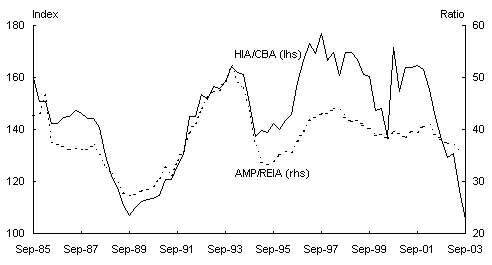
Source: Commonwealth Bank of Australia, Housing Industry Association, AMP and Real Estate Institute of Australia.
While the strong increase in house prices in recent years is well established, estimates as to the magnitude of this increase and the resulting size of the loan required to purchase a first home vary widely, with major implications for the overall indicator itself. For example, the Housing Industry Association/Commonwealth Bank of Australia indicator assumes an 80 per cent loan to valuation ratio on the market-wide median house price (which was approximately $320,000 in the September quarter 2003). The average first home loan size reported by the Australian Bureau of Statistics was closer to $186,000 in the September quarter 2003, significantly less than the median loan size on which the Housing Industry Association/Commonwealth Bank of Australia indicator is based.9 As such, prices paid (and loan sizes) by first home buyers appear less than what median house price estimates suggest. This is consistent with anecdotal evidence that suggests that first home buyers purchase less expensive homes, and in areas that have gone up less in price than the broader market.
Also, further caution should be exercised when interpreting such summary measures of affordability. While the significant rise in house prices has undoubtedly had a negative impact on the affordability of housing for first home buyers, summary measures tend to overstate the magnitude of changes in affordability because they do not fully depict the overall affordability picture for first home buyers.
By definition, the above measures are only an approximation of the conditions faced by aspiring first home buyers, and often use information related to overall market conditions rather than the conditions directly relevant to first home buyers. In addition, they may not include all the variables relevant in ascertaining home ownership. These other factors include strong employment outcomes and improved access to finance, which have exerted a positive influence on affordability in recent years.
While the loan required by first home buyers has increased significantly, there is evidence to suggest that first home buyers are not having trouble servicing higher debt levels. Liaison with major banks and mortgage originators indicates that the majority of first home buyers are ahead in their repayments and are repaying their loans more frequently than the standard monthly repayment. Also, default rates and mortgage insurance claims for first home buyers have fallen to very low levels, consistent with trends in the broader market.
The strong financial position of fi
rst home buyers is consistent with evidence that first home buyers generally have high incomes and are in full-time employment. Around two-thirds of first homebuyer households are ranked in the third, fourth and fifth income quintiles (see Chart 5). The relatively high average incomes of first home buyers possibly reflects the concentration of first home buyer households in the 25 to 44 years age cohort, who, on average, have higher incomes than say retirees.
Importantly, over the past twenty years, the income distribution of first home buyers has remained broadly unchanged, providing some evidence that people at the lower end of the income distribution are no less likely to become first home owners than they were twenty years ago.
Chart 5: Income distribution of first home buyers
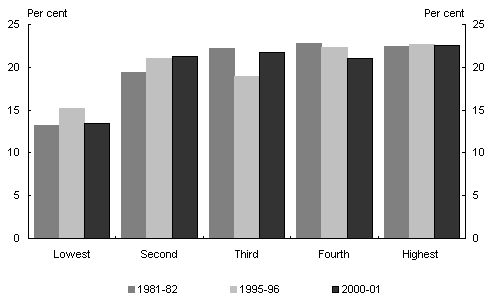
Source: Australian Bureau of Statistics, Survey of Income and Housing Costs, Cat. No. 6541.0.30.001.
Strong labour market outcomes have also helped first home buyers enter the market. In 2000-01, 90 per cent of first home buyers were in full-time employment while a further 3.6 per cent were in part-time employment (see Table 6). More recently, the unemployment rate for 25 to 34 year olds has fallen to 5.2 per cent, its lowest level since December 1989. In addition to strong employment outcomes, the relatively high proportion of first home buyers in full-time employment may also be an important element supporting affordability (Kupke and Marano, 2002).
Table 6: Employment status of first home buyers with a mortgage

Source: Australian Bureau of Statistics, Survey of Income and Housing Costs, Cat. No. 6541.0.30.001.
The structural decline in interest rates over the past decade has also played a significant role in improving aspiring first home buyers' access to the housing market. Since the 1990s, standard housing interest rates have fallen from a peak of 17 per cent to near 30-year lows of around 6.8 per cent currently. This reflects the fall in inflation over the period and the benefits of increased competition stemming from financial market deregulation.
Financial market deregulation has not only aided in a reduction in interest rates, but has increased the supply and diversity of lending products, making it easier for first home buyers to access the housing market.
Concluding remarks
While the strong rise in house prices in recent years has undoubtedly reduced affordability for first home buyers, the magnitude of the decline appears to have been overstated by some summary measures of affordability. This may reflect the limited nature of affordability measures or the fact that they are not well tailored to first home buyers.
First home buyer activity appears broadly consistent with demographic fundamentals, and recent declines in the level of first home buyers largely reflect an unwind of first home buyers brought forward by the FHOS.
Using recent first home buyers as a proxy for aspiring first home buyers, the article finds that access to the housing market has, to date, not been significantly reduced by the strong rise in house prices. Most first home buyers are middle to high income earners and have the stability of being in full-time employment. As a consequence, recent first home buyers are not having trouble paying down their loans, with many actually ahead of repayments.
Interestingly, while the average age of first home buyers appears to have increased over the past twenty years, since the mid-1990s this appears to have stabilised. More importantly, the ageing of the first home buyer cohort could be related to broader social developments rather than a decline in affordability. Such developments include the deferral of marriage and family formation, which typically precedes home purchase. In addition, higher prices being paid by first home buyers partly reflect the increasing size of their homes, consistent with the family motive of home purchase and the increasing size of homes more generally over the past two decades.
It should be remembered, however, that the various measures of affordability cited in this article are heavily influenced by conditions in the general economy and by the overall confidence of households. The strong domestic economy over the past decade has continued to provide opportunities for many first home buyers. Nevertheless, a significant slowing in economic activity especially with respect to employment, or a significant rise in interest rates, could have a detrimental affect on housing affordability. However, to the extent that such conditions could also impact on house prices - either slowing the rate of growth significantly or possibly reducing prices in some markets - this would lead to improved affordability.
References
Australian Bureau of Statistics, Cat. No. 5609.0, Housing Finance for Owner Occupation, Australia.
Australian Bureau of Statistics, Cat. No. 3201.0, Population by Age and Sex, Australian States and Territories.
Australian Bureau of Statistics, Survey of Income and Housing Costs.
Australian Bureau of Statistics (2003), `Home Ownership Across Australia' in Australian Social Trends (Cat. No. 4102.0).
Australian Bureau of Statistics (1999), `First Home Buyers' in Australian Social Trends (Cat. No. 4102.0).
Baum, S. and M. Wulff (2003), `Housing Aspirations of Australian Households: Final Report', Australian Housing and Urban Research Institute, Queensland Research Centre and Swinburne-Monash Research Centre.
Kupke, V. and W. Marano (2002), `The Implications of Changes in the Labour Market for the Ownership Aspirations, Housing Opportunities and Characteristics of First Home Buyers: Final Report', Australian Housing and Urban Research Institute, Southern Research Centre.
Troy, P. (1991), `The Benefits of Owner Occupation', Urban Research Program Working Paper No 29, Australian National University, Canberra.
Yates, J. (2002), `Housing Implications of Social, Spatial and Structural Change: Final Report', Australian Housing and Urban Research Institute, Sydney Research Centre.
1 Domestic Economy Division, Australian Treasury. This article has benefited from helpful comments from Damien Dunn and Dan Smith. I would also like to thank Joseph Mercante for invaluable data assistance. Any remaining errors and omissions are my own. The views in this article are those of the author and are not necessarily those of the Australian Treasury.
2 See, for example, Troy (1991).
3 Australian Bureau of Statistics (2003).
4 According to Kupke and Marano (2002), for recipients of the FHOS, the grant was the most important element in the timing of purchase.
5 Note that data for 2000-01 are preliminary.
6 An income unit is defined as a person or group of related persons within a household, whose command over income is assumed to be shared. Income sharing is assumed to take place within married (registered or defacto) couples, and between parents and dependent children.
7 Interestingly, a large proportion of first home buyers without a mortgage have very low reported incomes. Studies have found that households reporting very low incomes also often report expenditure levels that are higher than households with higher incomes, suggesting the need to exercise some caution with data at the lower end of the income distribution. This may reflect access to savings from past income or other sources of wealth, or because reported income includes low or negat
ive business income (Australian Bureau of Statistics, 2003).
8 The Commonwealth Bank/Housing Industry Association Housing Affordability Index is calculated as the ratio of average household disposable income to the minimum income required to be able to service a loan based on the current median house price and prevailing interest rate (qualifying income). The AMP/Real Estate Institute of Australia Home Loan Affordability Indicator is calculated as the ratio of family income to average loan payments.
9 Australian Bureau of Statistics, Housing Finance for Owner Occupation, Cat. No. 5609.0.